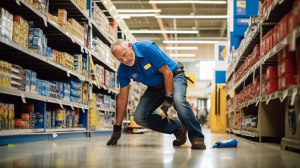The Importance of Store Layout in Preventing Injuries
When it comes to preventing injuries at Walmart, the store layout plays a crucial role. An effective store layout not only creates a visually appealing shopping environment but also ensures customer safety. Did you know that a poorly designed store can result in a higher likelihood of customer injuries? In this article, we will explore the various design and safety considerations retailers like Walmart should take into account to prevent customer injuries.
Aisles and Spacing: Providing Safe Navigation
A key aspect of store layout is the arrangement and width of aisles. Adequate aisle space is essential for customers to navigate the store safely and comfortably. If aisles are too narrow, shoppers may bump into one another, causing collisions or even slip and fall accidents.
Moreover, cluttered aisles with boxes or merchandise can create additional hazards for customers, particularly those with mobility issues or using carts or strollers. In extreme cases, cramped aisles can even hinder emergency evacuations. To ensure customer safety, retailers like Walmart should prioritize creating spacious, clearly marked aisles with enough room for shoppers to comfortably pass each other.
Shelving and Displays: Minimizing the Risk of Falling Objects
Proper shelving and display organization is another vital aspect of store layout that can significantly impact customer safety. Overstocked shelves or unstable displays can result in falling objects, posing a risk to customers below.
To prevent such incidents, Walmart should ensure that heavy items are placed on lower shelves and that displays are safely secured. Additionally, retailers should regularly inspect shelves and displays for any signs of wear or instability and address these issues promptly.
Signage: Guiding Customers Safely
Another design consideration that can impact customer safety is the use of effective signage. Clear and visible signs can help guide customers through the store and alert them to potential hazards. For example, wet floor signs can be used to caution customers about slippery surfaces and prevent slip and fall accidents.
In addition to hazard warnings, retailers should also provide clear and easily readable directional signage. This helps customers navigate the store efficiently, minimizing the chance of congestion or collisions in busy areas.
Lighting: Illuminating Potential Hazards
Proper lighting is essential for creating a safe shopping environment. Insufficient lighting can make it difficult for customers to see potential hazards, such as spills or uneven flooring, increasing the likelihood of accidents.
Retailers like Walmart should ensure that all areas of the store, including aisles, checkout lines, and restrooms, are well-lit and that lighting is regularly maintained to prevent dim or flickering bulbs. Additionally, using motion-activated or timed lighting in lesser-used areas, such as stockrooms or restrooms, can further enhance safety while conserving energy.
Flooring and Surfaces: Reducing Slip and Trip Hazards
Slip and fall accidents are one of the most common causes of customer injuries in retail stores like Walmart. To minimize the risk of these incidents, retailers should pay close attention to the type of flooring used throughout the store and ensure that it is slip-resistant and in good condition.
Furthermore, promptly addressing any spills or debris on the floor is essential for maintaining a safe shopping environment. Retailers can also use slip-resistant mats in areas prone to wetness, such as near entrances or produce sections.
Considerations for Customers with Disabilities
In addition to general store layout and design considerations, retailers should also take into account the needs of customers with disabilities. This can include providing accessible parking spaces, ramps, and wider aisles to accommodate wheelchairs or mobility scooters.
Additionally, retailers like Walmart should ensure that shelves and displays are easily accessible for customers with disabilities, and that staff are trained on how to assist customers who may require additional help.
Employee Training and Store Maintenance: Key to Customer Safety
While store layout plays a significant role in preventing customer injuries, it’s important to recognize that employee training and proper store maintenance are equally crucial. Employees should be trained to recognize and address potential hazards in the store and be knowledgeable about proper lifting techniques and ergonomics to prevent injuries while stocking shelves or assisting customers.
Furthermore, regular store inspections and maintenance can help identify and address any safety concerns before they become hazards. Retailers should establish a routine maintenance schedule and ensure that employees are aware of their responsibilities in maintaining a safe shopping environment.
Conclusion
In conclusion, the role of store layout in preventing Walmart customer injuries cannot be overstated. By considering design and safety factors such as aisle spacing, shelving organization, signage, lighting, and flooring, retailers can create a shopping environment that minimizes the risk of accidents and injuries.
Additionally, ensuring accessibility for customers with disabilities and providing proper employee training and store maintenance further contribute to a safe and enjoyable shopping experience. By prioritizing customer safety in their store layout and design, retailers like Walmart can reduce the likelihood of injuries, protect their customers, and maintain a positive reputation.




